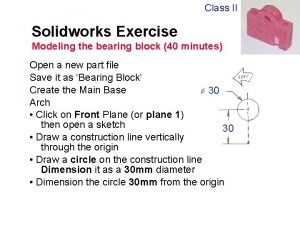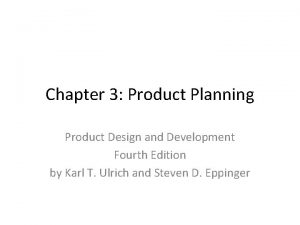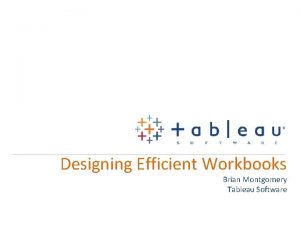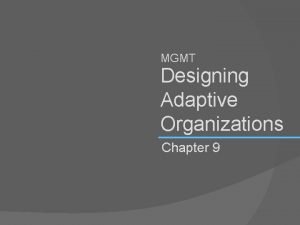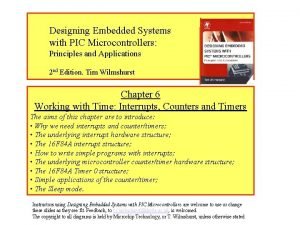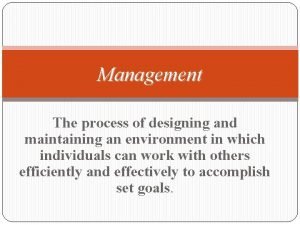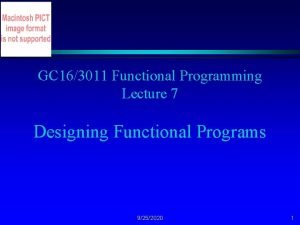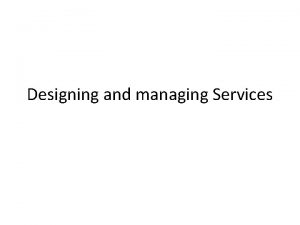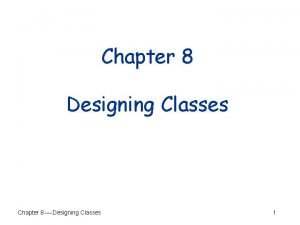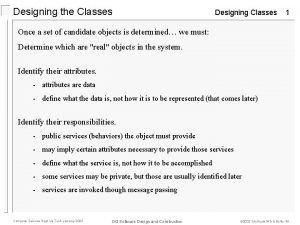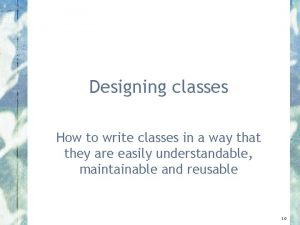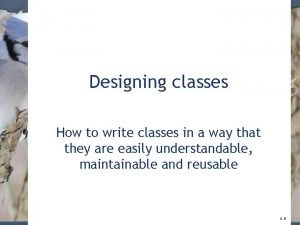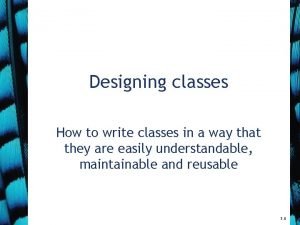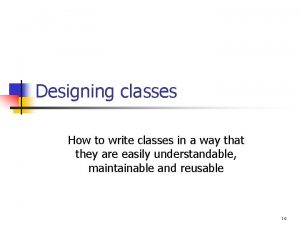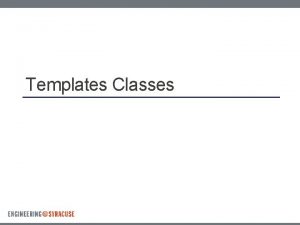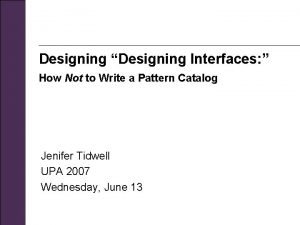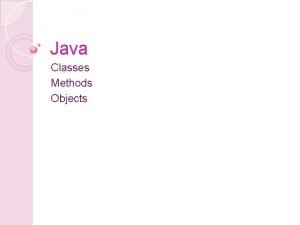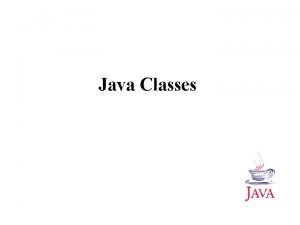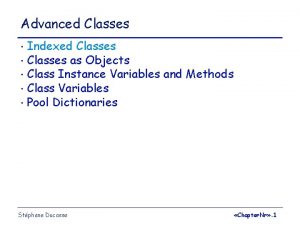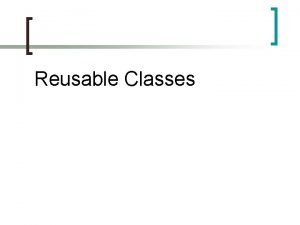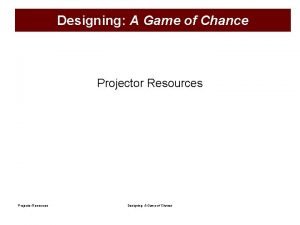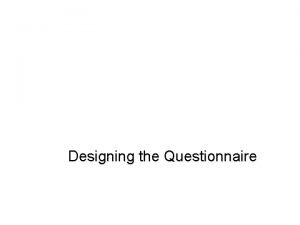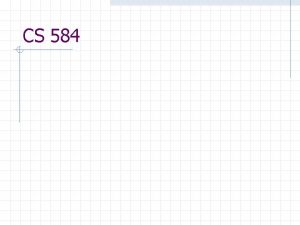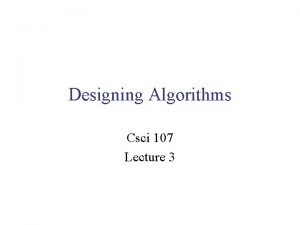Designing Classes How to write classes in a






























- Slides: 30

Designing Classes How to write classes in a way that they are easily understandable, maintainable and reusable

Main concepts to be covered • • Responsibility-driven design Coupling Cohesion Refactoring • Enumerations Objects First with Java - A Practical Introduction using Blue. J, © David J. Barnes, Michael Kölling 2

Software changes • Software is not like a novel that is written once and then remains unchanged. • Software is extended, corrected, maintained, ported, adapted … • The work is done by different people over time (often decades). Objects First with Java - A Practical Introduction using Blue. J, © David J. Barnes, Michael Kölling 3

Change or die • There are only two options for software: • • Either it is continuously maintained. . . Or it dies • Software that cannot be maintained will be thrown away. Objects First with Java - A Practical Introduction using Blue. J, © David J. Barnes, Michael Kölling 4

World of Zuul Objects First with Java - A Practical Introduction using Blue. J, © David J. Barnes, Michael Kölling 5

An Example • Add two new directions to the World of Zuul: • up • down • What do you need to change to do this? Objects First with Java - A Practical Introduction using Blue. J, © David J. Barnes, Michael Kölling 6

Code Quality • Two important concepts for quality of code: • Coupling – as little as possible please • Cohesion – as much as possible please Objects First with Java - A Practical Introduction using Blue. J, © David J. Barnes, Michael Kölling 7

Coupling • Coupling refers to links between separate units of a program. • If two classes depend closely on many details of each other, we say they are tightly coupled. • We aim for loose coupling. Objects First with Java - A Practical Introduction using Blue. J, © David J. Barnes, Michael Kölling 8

Loose Coupling • Loose coupling makes it possible to: • understand how to use a class without having to understand how that class works; • change the implementation of a class without affecting those classes that use it. This improves maintainability … makes change easier. Objects First with Java - A Practical Introduction using Blue. J, © David J. Barnes, Michael Kölling 9

Cohesion • Cohesion relates to: the number and diversity of tasks for which a single unit is responsible. • If a programming unit is responsible for one logical task, we say it has high cohesion. • Cohesion applies both at the level of classes and of methods. • We aim for high cohesion. Objects First with Java - A Practical Introduction using Blue. J, © David J. Barnes, Michael Kölling 10

High Cohesion • High cohesion makes it easier to: • understand what a class or method does (because it only does one thing); • Choose and use descriptive names; • reuse classes or methods. This improves usability … and makes change easier. Objects First with Java - A Practical Introduction using Blue. J, © David J. Barnes, Michael Kölling 11

Cohesion of Classes should represent just one, and only one, well defined entity. Cohesion of Methods A method should be responsible for one, and only one, well defined task. Objects First with Java - A Practical Introduction using Blue. J, © David J. Barnes, Michael Kölling 12

Code Duplication This is an indicator of bad design. It makes maintenance harder. It can lead to introduction of errors, especially during maintenance. Objects First with Java - A Practical Introduction using Blue. J, © David J. Barnes, Michael Kölling 13

Responsibility-Driven Design • Where should we add new fields and new methods (and to which class)? • The class that holds the data (fields) processes (methods) the data. • Responsibility-driven design leads to low coupling. Objects First with Java - A Practical Introduction using Blue. J, © David J. Barnes, Michael Kölling 14

Localising Change • One aim of reducing coupling and responsibility-driven design is to localise change. • When a change is needed, as few classes as possible should be affected. Improve maintainability … make change easier. Objects First with Java - A Practical Introduction using Blue. J, © David J. Barnes, Michael Kölling 15

Think Ahead • When designing a class, think what changes are likely to be made in the future. • Aim to make those changes easy. Improve maintainability … make change easier. Objects First with Java - A Practical Introduction using Blue. J, © David J. Barnes, Michael Kölling 16

Refactoring • When classes are maintained, code usually needs to be added. • Lists of fields, lists of methods and the code inside methods tend to become longer. • Every now and then, classes and methods should be refactored to maintain cohesion and low coupling. Objects First with Java - A Practical Introduction using Blue. J, © David J. Barnes, Michael Kölling 17

Refactoring and Testing • When maintaining code, separate the refactoring from making other changes. e. g. zuul-bad to zuul-better. • Do the refactoring first, without adding to the functionality. • Test before and after refactoring to ensure that nothing gets broken. Objects First with Java - A Practical Introduction using Blue. J, © David J. Barnes, Michael Kölling 18

Design Questions • Common questions: • • How long should a class be? How long should a method be? Answered with regard to cohesion and coupling. Objects First with Java - A Practical Introduction using Blue. J, © David J. Barnes, Michael Kölling 19

Design Guidelines • A method is too long if it does more then one logical task. • A class is too complex if it represents more than one logical entity. Note: these are guidelines … everything is still open to the designer. Objects First with Java - A Practical Introduction using Blue. J, © David J. Barnes, Michael Kölling 20

Enumerated Types • A new language feature. • Uses enum instead of class to introduce a new type name and a set of named constants of that type. • This is a better (safer) alternative to a set of named static int constants. • For the World of Zuul, we shall use names for command words, rather than string literals (which will appear only in one place). java. sun. com/docs/books/tutorial/java. OO/enum. html Objects First with Java - A Practical Introduction using Blue. J, © David J. Barnes, Michael Kölling 21

A basic enumerated type public enum Command. Word { // A value for each command word, // plus one for unrecognised commands. GO, QUIT, HELP, UNKNOWN zuu l-w ith -en um -v 1 } Enumerated objects are constructed implicitly. Each name represents an object of the enumerated type, e. g. Command. Word. HELP. Objects First with Java - A Practical Introduction using Blue. J, © David J. Barnes, Michael Kölling 22

Equivalent class type public class Command. Word { zuu l-w ith out -en um -v 1 // A object for each command word, // plus one for unrecognised commands. public final static Commandword GO = new Command. Word (); public final static Commandword QUIT = new Command. Word (); public final static Commandword HELP = new Command. Word (); public final static Commandword UNKNOWN = new Command. Word (); private Command. Word () { // nothing to do } } The constructor is declared private so that no Command. Word objects, other than the ones declared here, can be constructed. Objects First with Java - A Practical Introduction using Blue. J, © David J. Barnes, Michael Kölling 23

Another enumerated type public enum Command. Word { // A value for each command word, // plus one for unrecognised commands. GO("go"), QUIT("quit"), HELP("help"), UNKNOWN("unknown"); private String command. String; private Command. Word (String command. String) { this. command. String = command. String; } public String to. String () { return command. String; } v 2 um n e th i l-w u zu } Objects First with Java - A Practical Introduction using Blue. J, © David J. Barnes, Michael Kölling 24

Equivalent class type public class Command. Word { // A object for each command word, // plus one for unrecognised commands. public final static Commandword GO = new Command. Word ("go"); public final static Commandword QUIT = new Command. Word ("quit"); public final static Commandword HELP = new Command. Word ("help"); public final static Commandword UNKNOWN = new Command. Word ("? "); . . . } v 2 um n e uto ith w ul zu private final field (String) private constructor (to construct above constants) public to. String (returns String field) public static values (returns array of above constants) Automatically provided by an enum Objects First with Java - A Practical Introduction using Blue. J, © David J. Barnes, Michael Kölling 25

Equivalent class type public class Command. Word { // A object for each command word, // plus one for unrecognised commands. public final static Commandword GO = new Command. Word ("go"); public final static Commandword QUIT = new Command. Word ("quit"); public final static Commandword HELP = new Command. Word ("help"); public final static Commandword UNKNOWN = new Command. Word ("? "); private final String command. String; v 2 um n e uto ith w ul zu private Command. Word (String command. String) { this. command. String = command. String; } 26 Objects First with Java - A Practical Introduction using Blue. J, © David J. Barnes, Michael Kölling

Equivalent class type public class Command. Word {. . . public final statics (GO, QUIT, HELP, UNKNOWN) private final String command. String; private Command. Word (String command. String) { this. command. String = command. String; } public String to. String () { return command. String; } } v 2 um n e uto ith w ul zu public static Command. Word[] values () { return new Command. Word[] {GO, QUIT, HELP, UNKNOWN}; } Automatically provided by an enum 27 Objects First with Java - A Practical Introduction using Blue. J, © David J. Barnes, Michael Kölling

See also … zuu l-w ithenu m-v 1 zuu l-w ithenu m-v 2 -v 1 m u -en t u itho w l zuu -v 2 m u -en t u itho w l zuu -v 3 m nu e t u tho i w lzuu l-be tter projectschapter 07 -v 4 m u -en t u tho i w lzuu coursesco 882projects-phw Objects First with Java - A Practical Introduction using Blue. J, © David J. Barnes, Michael Kölling 28

Review • Programs are continuously changed. • It is important to anticipate change and make it as easy as possible. • Quality of code requires much more than just performing correctly! • Code must be understandable and maintainable. Objects First with Java - A Practical Introduction using Blue. J, © David J. Barnes, Michael Kölling 29

Review • Good quality code avoids duplication, displays high cohesion, low coupling. • Coding style (commenting, naming, layout, etc. ) is also very important. • There is a big difference in the amount of work required to maintain poorly structured and well structured code. • In fact, unless it is well structured, the code is doomed … it will not be used for long. Objects First with Java - A Practical Introduction using Blue. J, © David J. Barnes, Michael Kölling 30
 Solidworks
Solidworks Class e subclasse
Class e subclasse Pre ap classes vs regular classes
Pre ap classes vs regular classes Cache memory mengacu pada konsep locality of reference
Cache memory mengacu pada konsep locality of reference Zip line sag calculation
Zip line sag calculation Lower rpd design
Lower rpd design Designing assessment tasks
Designing assessment tasks Quality service by design
Quality service by design Product platform
Product platform What is output design in system analysis and design
What is output design in system analysis and design Marketing programs to build brand equity
Marketing programs to build brand equity Designing efficient workbooks tableau
Designing efficient workbooks tableau Obero spm
Obero spm Chapter 7 designing organizational structure
Chapter 7 designing organizational structure A case study designing a document editor
A case study designing a document editor Matrix departmentalization
Matrix departmentalization Designing adaptive organizations
Designing adaptive organizations Designing and implementing branding strategies
Designing and implementing branding strategies Pic architecture diagram
Pic architecture diagram The process of designing and maintaining an environment
The process of designing and maintaining an environment Chapter 4 designing studies
Chapter 4 designing studies Where were sneakers manufactured until the 1960s
Where were sneakers manufactured until the 1960s Designing and managing value networks
Designing and managing value networks Ltorg in system programming
Ltorg in system programming Objectives of human resource information system
Objectives of human resource information system Nivea brand architecture
Nivea brand architecture Layout
Layout Designing functional programs
Designing functional programs Characteristics of services
Characteristics of services Contoh strategi pesan
Contoh strategi pesan High value deal seekers
High value deal seekers
